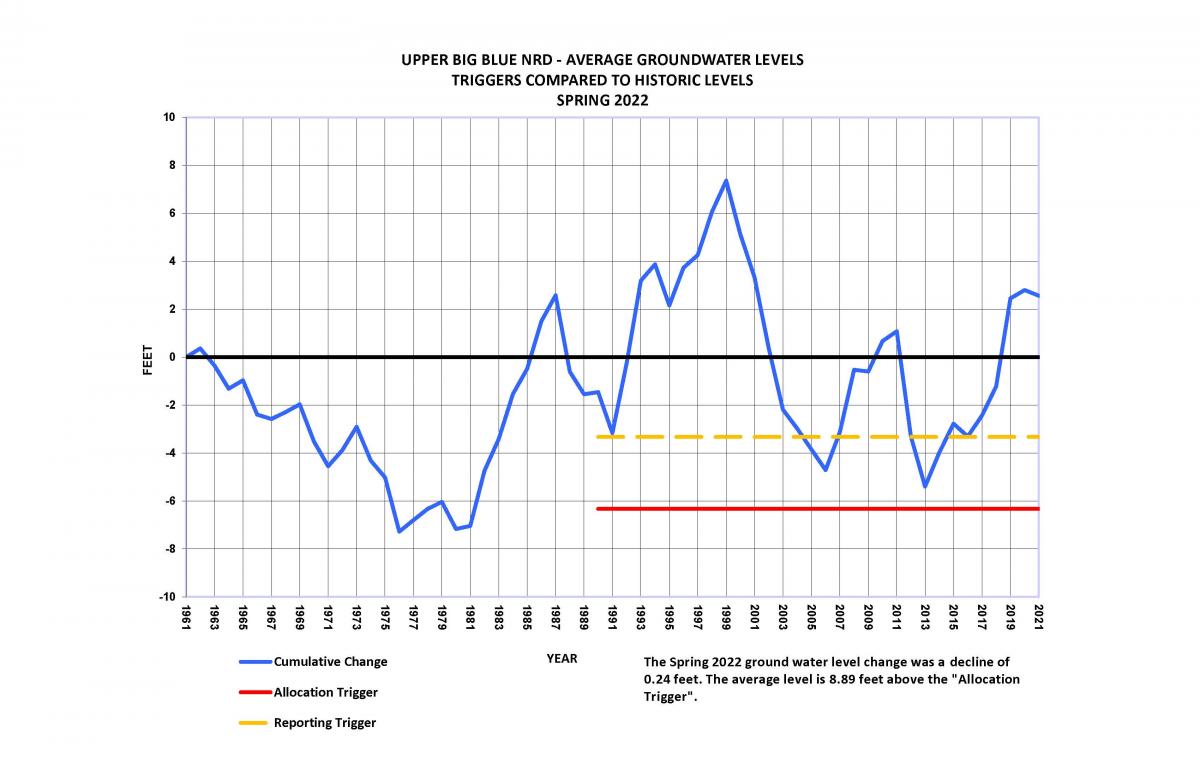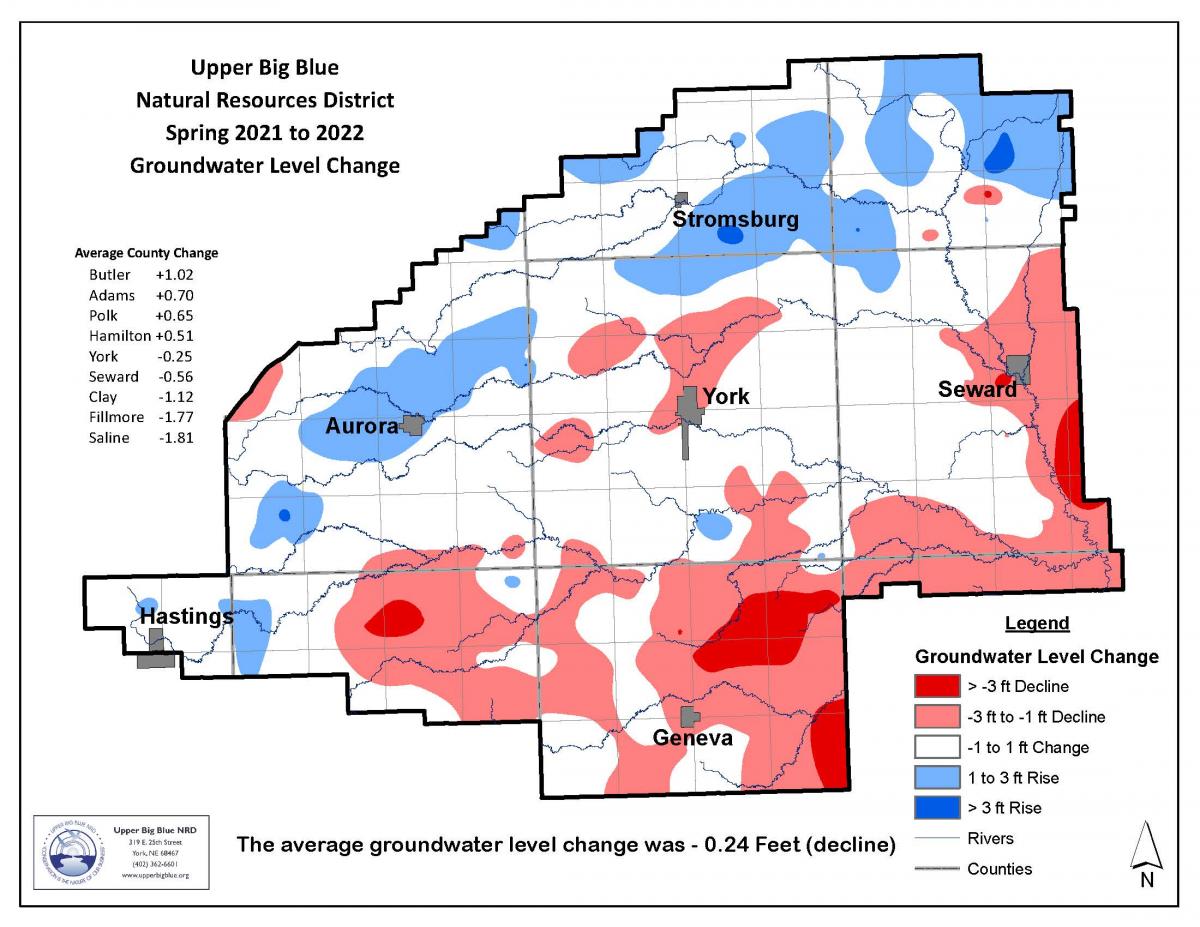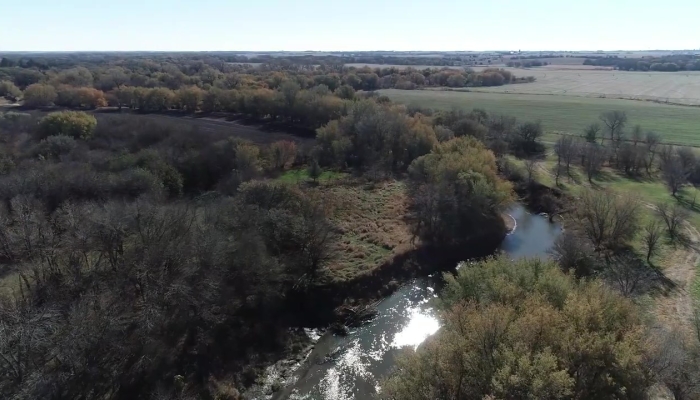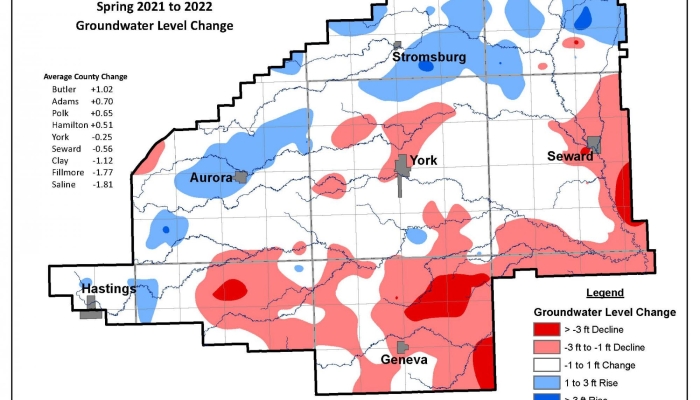NRD Reports Small Average Water Level Decline
Groundwater level declines, yet remains well above allocation trigger
During March and April 2022, staff of the Upper Big Blue Natural Resources District measured roughly 500 observation wells throughout the district to determine an average water level change, based on a weighted change from each well. For spring 2022 water level measurements, the NRD has determined that the average groundwater level change shows a decline of 0.24 feet from last spring. The spring 2022 average groundwater level is now 8.89 feet above the “Allocation Trigger.” Thus, there will be no allocation restrictions for the 2023 irrigation season.
Observation wells are measured in the spring of each year, allowing the water table to rebound from the previous irrigation season. The wells that are measured are uniformly distributed throughout the district to provide an accurate profile of the average groundwater level change. Each well measured is assigned an area of the district based on distances from other wells. This method gives the average groundwater level change a weighted average.
In spring 2021, the NRD reported an average increase of 0.35 feet. Spring 2020 showed an increase of 3.67 feet on average. Fluctuations from year to year are common throughout the district. The Upper Big Blue NRD sits above the High Plains Aquifer, which stretches from South Dakota to Texas. This portion of the aquifer is dynamic and different factors like rainfall and pumping affect how the aquifer reacts.
In addition to the average change across the district, the NRD has also provided a more detailed look at water levels across the district. Water levels rose slightly in the north and west parts of the district, including Butler, Adams, Polk, and Hamilton counties. Water levels decreased from 1 to 2 feet in the south and east part of the district, including York, Seward, Clay, and Fillmore Counties. Saline county saw the biggest decline, with a drop of 1.81 feet.
Water use records enable informed management decisions and practices
In recent years, producers have done an exceptional job of managing use of district water resources and cooperating with the NRD on conservation activities and monitoring. Along with NRD staff measuring observation wells, all groundwater users are required to annually report their water use. This is how the NRD maintains records on historic groundwater usage. Groundwater use records are very important to the district for making informed management decisions. The 2021 district average groundwater usage was 6.7 inches/acre. The district average groundwater usage is 5.9 inches/year since 2007.
The district’s goal is to hold the average groundwater level at or above the 1978 level. In 2005, the district average groundwater level reached the “Reporting Trigger”, initiating mandatory reporting of annual groundwater use to the district and certification of irrigated acres. If the district average water level falls below the 1978 level (“Allocation Trigger”), groundwater allocation will begin.


During March and April 2022, staff of the Upper Big Blue Natural Resources District measured roughly 500 observation wells throughout the district to determine an average water level change, based on a weighted change from each well. For spring 2022 water level measurements, the NRD has determined that the average groundwater level change shows a decline of 0.24 feet from last spring. The spring 2022 average groundwater level is now 8.89 feet above the “Allocation Trigger.” Thus, there will be no allocation restrictions for the 2023 irrigation season.
Observation wells are measured in the spring of each year, allowing the water table to rebound from the previous irrigation season. The wells that are measured are uniformly distributed throughout the district to provide an accurate profile of the average groundwater level change. Each well measured is assigned an area of the district based on distances from other wells. This method gives the average groundwater level change a weighted average.
In spring 2021, the NRD reported an average increase of 0.35 feet. Spring 2020 showed an increase of 3.67 feet on average. Fluctuations from year to year are common throughout the district. The Upper Big Blue NRD sits above the High Plains Aquifer, which stretches from South Dakota to Texas. This portion of the aquifer is dynamic and different factors like rainfall and pumping affect how the aquifer reacts.
In addition to the average change across the district, the NRD has also provided a more detailed look at water levels across the district. Water levels rose slightly in the north and west parts of the district, including Butler, Adams, Polk, and Hamilton counties. Water levels decreased from 1 to 2 feet in the south and east part of the district, including York, Seward, Clay, and Fillmore Counties. Saline county saw the biggest decline, with a drop of 1.81 feet.
Water use records enable informed management decisions and practices
In recent years, producers have done an exceptional job of managing use of district water resources and cooperating with the NRD on conservation activities and monitoring. Along with NRD staff measuring observation wells, all groundwater users are required to annually report their water use. This is how the NRD maintains records on historic groundwater usage. Groundwater use records are very important to the district for making informed management decisions. The 2021 district average groundwater usage was 6.7 inches/acre. The district average groundwater usage is 5.9 inches/year since 2007.
The district’s goal is to hold the average groundwater level at or above the 1978 level. In 2005, the district average groundwater level reached the “Reporting Trigger”, initiating mandatory reporting of annual groundwater use to the district and certification of irrigated acres. If the district average water level falls below the 1978 level (“Allocation Trigger”), groundwater allocation will begin.




